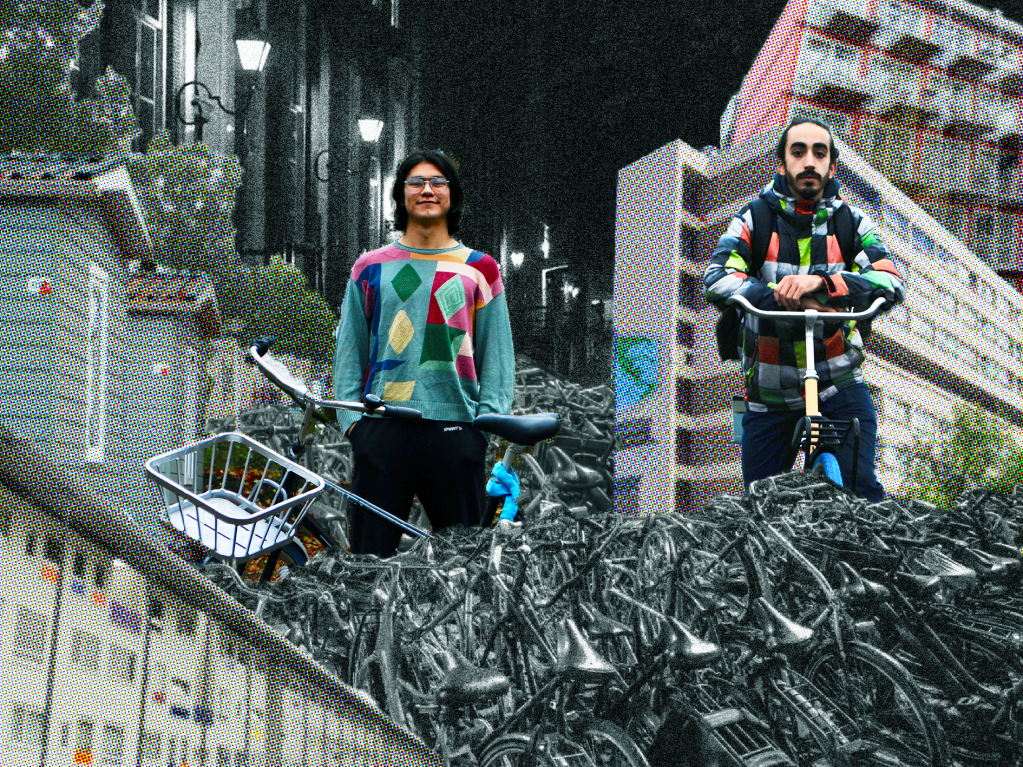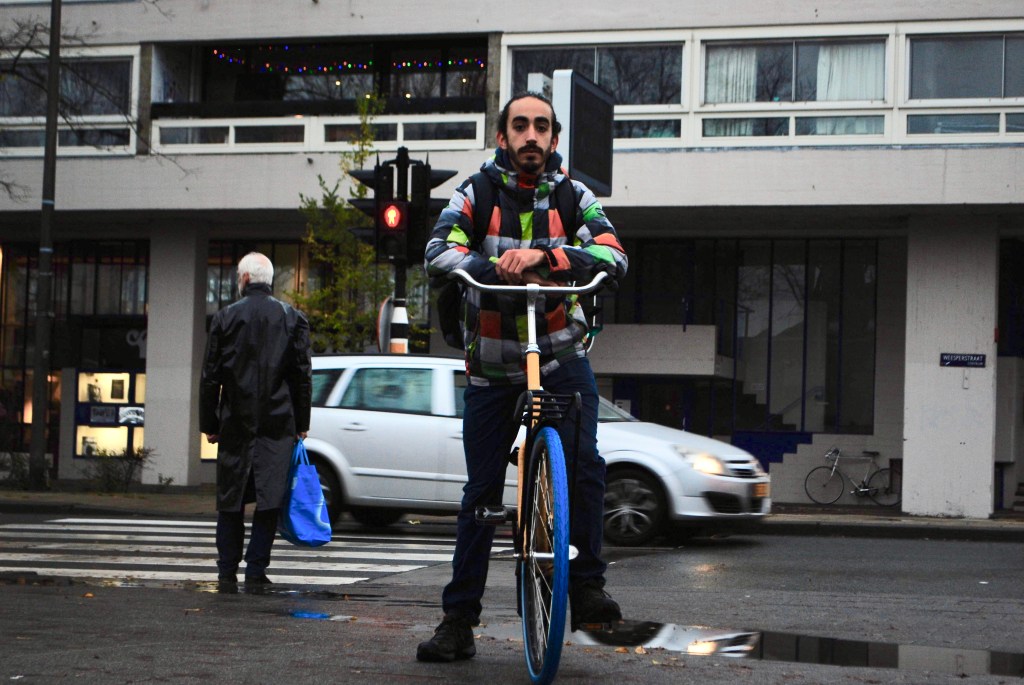By Levin Stamm

—The apartment complex at Weesperstraat blends smoothly into Amsterdam’s hostile November weather. Luis Guzmán cannot help but look wistfully up the bare facade of the grey concrete block. “That’s exactly where I had my room,” he says, pointing his finger at one of the many small windows on the second floor. Guzmán, originally from Almería, Spain, is in his second year of the European Studies programme at the Universiteit van Amsterdam (UvA) – and has been homeless since coming back to Amsterdam from summer break.
Guzmán is just one of many. At the start of the 2021-2022 academic year, there were hardly any empty apartments in the Dutch capital – and certainly none of the around 13,000 student housing units. Among the reasons; the skyrocketing number of students at the universities. At the Vrije Universiteit (VU), 12,622 new bachelor’s and master’s students enrolled, at the UvA even 14,971 – too many to accommodate them all in the already overheated Amsterdam housing market.
Another record year of student enrolment that sets the university managements’ alarm bells ringing: “Of course it is wonderful that VU Amsterdam is so much appreciated by students. Yet I mainly feel discomfort Our people are already working too hard and we simply cannot cope with this growth without the corresponding funding. The situation is now very worrying,” said Mirjam van Praag, president of VU’s Executive Board in the beginning of November. UvA counterpart Geert ten Dam took the same line: “The pace at which student numbers at the UvA – and also at other Dutch universities – are increasing, is no longer manageable,” she said.
“Honestly, I could have passed my university course. But guess what? Instead of spending one or two hours studying per day, I was looking for a room.”
Luis Guzmán
Guzmán has to experience firsthand that the universities are reaching their pain threshold. Here at Weesperstraat, a five-minute bike ride from UvA’s Roeterseiland campus, he spent his first year in student housing. But because UvA only provides each student with accommodation for one year, Guzmán has been without a place to live since August. “It sounds so silly now, but I even wanted to move out early at some point,” he says. The monthly 390 euros he used to pay for his former 12-square-meter room suddenly seem like an unbeatable bargain.
Instead of student-friendly rent rates, he now faces the unforgiving forces of the unregulated vrije sector, or free market, where exorbitant rents become a challenge even for full-time workers. A studio in a good location quickly costs 1300 euros, a two-bedroom apartment 3000 euros.

In Guzmán’s price class, the shortage of available apartments is even more acute. “I started searching in February when it was clear that I would eventually have to move out,” Guzmán says. The meager yield of over 200 requests on Facebook, Kamernet and other platforms for rental properties: 15 responses, of which five were negative and four scams. From the remaining people who invited him to a viewing, he never got a response afterwards.
At a small table in the student-run CREA café on the UvA’s Roeterseiland campus, Guzmán hastily sketches a floor plan on a sheet of paper. “This is how it looked, but smaller,” Guzmán says. A bed, a table and a TV take up almost all of the space of the 12-square-meter studio located in Haarlemmerbuurt, right next to Amsterdam Centraal Station. This is where he lived from the beginning of August until the end of November at the kindness of a friend. “Every night we had to move all the furniture to the walls for my mattress to fit,” Guzmán says.
The precarious housing situation has left its mark – in every aspect of life, as Guzmán admits. With university, work and the many hours he spends scrolling through housing portals, there is little space, literally and figuratively, for a social or romantic life. “Everything just requires so much more planning when you don’t have your own place,” he says. Mentally strained, Guzmán has also dropped one of his university courses. “Honestly, I could have passed it. But guess what? Instead of spending one or two hours studying per day, I was looking for a room.”
After two and a half months, his friend told him that he had to move out. “The situation just got us both totally exhausted. But I’m so lucky that he put up with me for so long in the first place,” Guzmán says. He has now gotten back to couch hopping and currently stays with a friend in the outskirts of Amsterdam.
“The universities should communicate like tobacco companies – ‘studying in Amsterdam may leave you homeless’, on top of all their websites.”
Job Vermaas
The exact number of students in Guzmán’s situation remains unclear. “At the moment, we have an estimated shortage of 6600 student housing units in Amsterdam,” knows Job Vermaas, General Board Member at the Algemene Studenten Vereniging Amsterdam (ASVA), the student union of the UvA and the Hogeschool van Amsterdam (HvA). He represents students’ interests when it comes to housing and regularly sits down with the universities, housing corporations and the municipality.
Vermaas expects the actual shortage to be much higher; the estimate of the current shortage is only based on students who are actively looking for an apartment. “Many international students stay under the radar because they illegally rent or sublet, while Dutch students often keep living with their parents despite wanting to move out,” Vermaas says. A look at communications from the VU confirms Vermaas’s fear. In October, the VU’s International Office stated that 75 students are registered to find housing, while SRVU, the VU’s student union, knows of 230 homeless international students.

The ASVA also notices an increase in the amount of homeless students asking for help – and has set up a couchsurfing platform to help them out of their imminent malaise. “But obviously, this is not more than a drop in the bucket,” Vermaas says. He sees the universities as having the responsibility to take action: “They are not totally upfront about the current housing situation in Amsterdam and don’t tell international students the whole story.” Guzmán sees it similarly: “It’s so hypocritical that they call themselves the best university in the Netherlands. Sure, whatever. Their students don’t even have a place to live.”
According to Vermaas, the universities’ inconsequential communication is the reason why many students move to Amsterdam despite not being able to afford the free market prices. “They should communicate like tobacco companies – ‘studying in Amsterdam may leave you homeless’, on top of all their websites,” he says.
The situation has gotten so out of control that even first-year bachelor’s students end up being waitlisted for student housing. To avoid them starting their university career in the streets of Amsterdam, the UvA and the VU have set up emergency housing units. In the past years, they were installed among others in the Bijlmerbajes, a former prison complex, or in the 200-person hamlet of Spaarnwoude – 20 kilometres away from Amsterdam.
UvA spokesman Nick Beston confirms that the universities have also been offering “alternative accommodation” in the current academic year. One option includes the Stayokay hostel in Amsterdam Oost. For 418,50 euros a month, students get a dorm room to be shared with two other people. Sharing a smaller room with only one other person costs them 90 euros more.
“Many leave their homes for the first time, thinking that they are going on this exciting university adventure in Amsterdam. To then end up here is emotionally crushing,”
JOsé María Justes Torres
Those who cannot afford the hefty rents of the emergency accommodation in the centre become backwoodsmen – in the truest sense of the word. On the edge of Amsterdamse Bos, just a few hundred metres from Schiphol Airport, José María Justes Torres puts his bicycle in front of his mobile home. The local camping site where he has been living since mid-August bears the name City Camping, although the reception’s wooden facades mimicking the centre’s canal houses are the only thing reminiscent of Amsterdam.
Justes Torres is a first-year student in the UvA’s Media and Culture programme – and one of the 30 students who currently make use of the universities’ extra housing option in Amsterdamse Bos. Where nature-loving Amsterdammers usually spend their weekends, the Mexican has set up his home during the last months. In the sparsely furnished living room at least the electric heating provides some warmth. His room, on the other hand, remains unheated – who would have expected that people would sleep here during the winter months? Most of Justes Torres’s few possessions are still stowed away in his suitcase, ready to be taken to another place as soon as possible. “It does feel like being stranded.”
Justes Torres’s temporary home is 14 kilometres away from the Roeterseiland campus – or a 45-minutes bike ride. “At least I have become fit while living here,” he says. Cycling back and forth several times a week, Justes Torres estimates to have cycled over 2000 kilometres since he moved to Amsterdamse Bos. That was fine in August, but he admits that the cold and the rain have made it “tougher.”

The impact of the distance on students’ lives reaches much further. Justes Torres points out the needed willpower to “live in the forest.” “Either to stand the nothingness of this place or you actually do all the cycling to the centre every day,” he says. He describes an “eerie atmosphere” of physical and mental exhaustion that has taken over the camping site in the last months.
One of his neighbours, also a first-year UvA bachelor’s student, only found out upon arrival that her apartment was a scam. Another one from the VU got evicted by the landlord at short notice. “Many leave their homes for the first time, thinking that they are going on this exciting university adventure in Amsterdam. To then end up here is emotionally crushing,” Justes Torres says.
Nevertheless, Amsterdamse Bos is Justes Torres’s best option for now. The 335 euros of monthly rent for the trailer is better than any room he has seen in the many months he spent scrolling through housing portals. “I could also move to Bijlmer. But living only a few kilometres closer to the university for the double amount of rent, is that really worth it?”
Soon he might have no other choice. The UvA’s and VU’s emergency housing programme ends on February 4. What then for the 70 students who are currently staying at the Stayokay hostel or the City Camping in Amsterdamse Bos? “Students who have not found anything by then can be helped by us if cancellations come in due to, for example, COVID or because students stop their studies,” UvA spokesman Beston says. A light at the end of the tunnel? Justes Torres is skeptical: “The university arranged our current housing to keep us from being homeless. I mean, it’s better than nothing that we may have a chance to stay, but it’s also kind of ridiculous.”
Since September, he has been looking for new housing and has also signed up at an agency that is supposed to arrange viewings for him. But even this proves to be difficult in the current market situation: “I normally send a request within hours after an offer appears on my profile, but I don’t even get an invite for a viewing, the apartment is always already gone by the time they reply,” Justes Torres says, adding that by now he feels lucky whenever he gets a response at all.
For a long time, it seemed like the lack of affordable housing for students like Justes Torres and Guzmán could at least be alleviated by a housing project in Kronenburg, a dilapidated office district of Amsterdam’s neighbouring municipality Amstelveen. 2500 students were supposed to find a new home here by 2025. Student housing corporation DUWO, the universities, the municipality, the province of North Holland and the Dutch Ministry of the Interior had all given their blessings – were it not for the Dutch Ministry of Infrastructure and Water Management. At the beginning of November, it jammed on the brakes at the last second. The reason: It is concerned that the aircraft noise from nearby Schiphol airport may have negative impacts on the students’ health.
“Do you want Schiphol to grow or do you want students and other people to have housing? To me, that seems like an easy decision.”
Job Vermaas
Student unionist Vermaas has little understanding for the ministry’s decision: “It’s part of a much larger issue,” he says and points to a recent statement of Lex Brans, North Holland’s construction ambassador, who has the task to speed up the time-consuming approval procedures for new housing projects. “We are anticipating that as a result, of the 175,000 homes needed in the Amsterdam Metropolitan Area until 2030, 60,000 to 70,000 will not be able to be built,” Brans told Het Parool in regard to the current regulations around aircraft noise for housing projects.
Upsetting for Vermaas and the ASVA: While social student housing projects like Kronenburg have repeatedly been stopped in recent years, Schiphol Airport plans to expand further. Due to a 2019 Council of State decision that strictly limits the national emission levels of nitrogen, this would make it even harder for new housing projects to get approved. “Do you want Schiphol to grow or do you want students and other people to have housing?” Vermaas says, “to me, that seems like an easy decision.”
Jos Bakker, a spokesman at the Kenniscentrum Studentenhuisvesting (Kences), also notes the current developments in the Dutch student housing market with concern. Kences is the umbrella organisation of 13 Dutch student housing corporations and regularly conducts research on the current social student housing situation. DUWO and De Key, the two biggest players in the market, are also part of it. “There are still too many obstacles that inhibit the construction of more social student housing,” Bakker says.
He criticises the current rent ceiling for rooms with shared facilities. “The current maximum amounts are simply too low for the corporations to build without a big loss,” Bakker says. This would discourage investors from building social student housing. “Instead, it’s more favourable for them to put their money into houses and apartments,” he says.
Kences expects that the shortage of student housing units in the Amsterdam metropolitan area will increase up to 21,500 by 2028 – nationwide even up to 76,000. Among the reasons: Since the mid-nineties, the Dutch Ministry of Education, Culture and Science had underestimated the number of students in higher education due to an error in its calculation model, which was only discovered this summer; too late for the student housing corporations that had made their plans according to the Ministry’s predictions.
The amount of international students at Amsterdam’s universities has increased more quickly than expected. Bakker believes that regulating the influx of international students could ease the current situation – an opinion also shared by Vermaas: “We have to make sure that there is a limit to the amount of international students coming to Amsterdam. I’d rather have them go to another university than be a victim of the current situation here.”
Before the tangled web of factors that leaves Amsterdam’s international students homeless is resolved, thousands more of them will suffer the same fate as Justes Torres and Guzmán. While Justes Torres is getting more and more anxious about his approaching eviction at the beginning of February, Guzmán already feels disillusioned: “I have cried more in the past months than in the previous two years combined – if I don’t find anything soon I might as well go back to Spain.”
Author’s note: By the end of January, Guzmán and Justes Torres have both found a place to stay in Amsterdam. While Guzmán has found a room in a friend’s apartment, Justes Torres will move into UvA student housing at the beginning of February.
